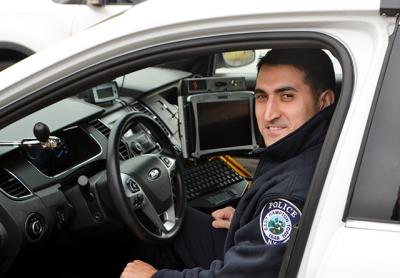Cops Freed From Painful Schedule

Starting at 6 a.m. New Year’s Day, the East Hampton Town Police Department, in one of the most sweeping changes in years, switched from a system of rotating shifts to a set schedule. The net effect will be more officers on the beat as well as a healthier police force, Chief Michael D. Sarlo said.
“The new schedule is a 12-hour tour chart with officers assigned to straight day shifts or straight nights,” Chief Sarlo said Tuesday. With P.B.A. agreement, the new schedule will be tried for a year, after which adjustments will be possible.
“The goal is to both give the officers a set schedule to improve their sleep cycles and standardize their shifts, as well as increase the available staffing levels and improve coverage on the road. With the new schedule, there will be on average two to three more officers each patrol shift, and on weekends there will be an additional four or five officers assigned to a routine patrol shift.”
According to Anthony Bosco, a member of the force as well as head of the East Hampton Town Police Benevolent Association, the quest for a revised schedule predates his almost 10 years on the force.
In an article in The Star in 2013, Joseph Fallacara, then head of the P.B.A., described the negative impact of rotation on rank and file officers. “The divorce rate with regular civilians is 55 percent. With cops, it’s about 90 percent. It takes a year off your life each year you do it,” he said.
Officers had been divided into five squads, which rotated through three time-slots in a roughly three-week cycle. The first shift ran from 7 a.m. to about 3 p.m., followed by an afternoon shift from about 3 to about 11, and then, after two consecutive days off, officers had the night shift, from 11 p.m. to 7 a.m. With the new schedule, each officer chose whether to work on the day or night shift before the year began, based on seniority.
Members of the force will now work in two-week cycles, alternating between two and three days on and two or three days off. The total number of days worked per year will drop, but the hours will remain roughly the same.
While rank and file officers were hesitant to speak for attribution, off the record, many were pleased. “It’s a long time coming,” one said. “For the first time in a long time, I know what time I’m going to sleep tonight,” another said. “I’m glad for something steady,” said an officer who chose to work during the day. “I haven’t heard anything negative. Everyone I’ve talked to is excited.”
The current head of the P.B.A. said the department and town officials began to home in on the new schedule after Labor Day. “We looked through a lot of different schedules. Eight hours, 10 hours, other 12-hour formats. None of them actually made sense,” Mr. Bosco said yesterday, at least until the final schedule was discussed.
The one-year trial period, the chief said, will allow adjustments in the schedule and management of the shifts at the end of the year, before becoming permanent. The P.B.A.’s contract runs to 2020.
“The health benefits for the officers are immeasurable, and the health and well-being of our people is extremely important,” the chief said. “Twelve hours is a long shift, but with overtime and special assignments, as well as grant-funded shifts, many officers were already extending their regular eight-hour tours into 12-hour shifts throughout the summer months.”
Among the grant-funded shifts the chief referred to is the effort to stop drunken driving operated from the county district attorney’s office, which pulls and pools officers from different departments to target different localities on weekend nights, particularly during the summer.
“I would also add that increased personnel within our department, with three additional officers added to our budget last year, as well as three officers retiring from line-of-duty injuries and being replaced, has helped us finally reach the staffing goals that make this schedule feasible for us to test out. It has been four years in the making.”
Mr. Bosco echoed a sentiment expressed by the chief, giving credit to the East Hampton Town Board “for enabling us to make the changes.”
In other town police news, the final weekly police report for 2016 indicates that calls for incidents of all kinds surpassed the record-setting number of about 19,685 in 2015 by about 200. Arrests skyrocketed to 848, an increase of over 100 from 2015, or almost 14 percent. That number includes arrests for both violations and criminal charges. The final figures will be sorted out over the next few weeks, when the chief reviews the year in a presentation to the town board.
